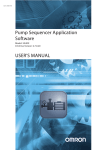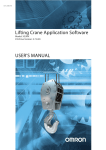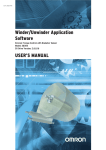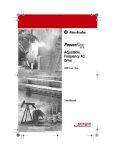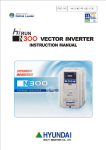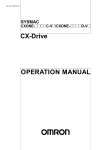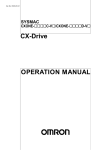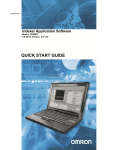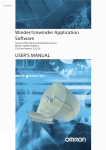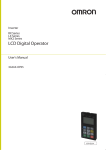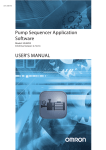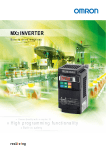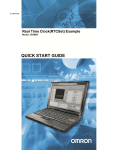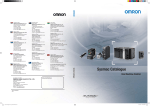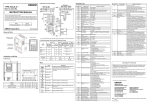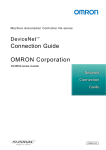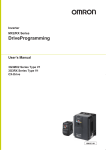Download Low Performance Lift Application Software
Transcript
Cat. No. I217E-EN-01 Model: 3G3MX2 CX-Drive Version: 2.9.0.23 Notice: OMRON products are manufactured for use according to proper procedures by a qualified operator and only for the purposes described in this manual. The following conventions are used to indicate and classify precautions in this manual. Always heed the information provided with them. Failure to heed precautions can result in injury to people or damage to property. OMRON Product References All OMRON products are capitalized in this manual. The word “Unit” is also capitalized when it refers to an OMRON product, regardless of whether or not it appears in the proper name of the product. OMRON, 2014 All rights reserved. No part of this publication may be reproduced, stored in a retrieval system, or transmitted, in any form, or by any means, mechanical, electronic, photocopying, recording, or otherwise, without the prior written permission of OMRON. No patent liability is assumed with respect to the use of the information contained herein. Moreover, because OMRON is constantly striving to improve its high-quality products, the information contained in this manual is subject to change without notice. Every precaution has been taken in the preparation of this manual. Nevertheless, OMRON assumes no responsibility for errors or omissions. Neither is any liability assumed for damages resulting from the use of the information contained in this publication. Low Performance Lift Application Software Read and Understand this Manual Please read and understand this manual before using the product. Please consult your OMRON representative if you have any questions or comments. Warranty and Limitations of Liability WARRANTY OMRON's exclusive warranty is that the products are free from defects in materials and workmanship for a period of one year (or other period if specified) from date of sale by OMRON. OMRON MAKES NO WARRANTY OR REPRESENTATION, EXPRESS OR IMPLIED, REGARDING NON-INFRINGEMENT, MERCHANTABILITY, OR FITNESS FOR PARTICULAR PURPOSE OF THE PRODUCTS. ANY BUYER OR USER ACKNOWLEDGES THAT THE BUYER OR USER ALONE HAS DETERMINED THAT THE PRODUCTS WILL SUITABLY MEET THE REQUIREMENTS OF THEIR INTENDED USE. OMRON DISCLAIMS ALL OTHER WARRANTIES, EXPRESS OR IMPLIED. LIMITATIONS OF LIABILITY OMRON SHALL NOT BE RESPONSIBLE FOR SPECIAL, INDIRECT, OR CONSEQUENTIAL DAMAGES, LOSS OF PROFITS OR COMMERCIAL LOSS IN ANY WAY CONNECTED WITH THE PRODUCTS, WHETHER SUCH CLAIM IS BASED ON CONTRACT, WARRANTY, NEGLIGENCE, OR STRICT LIABILITY. In no event shall the responsibility of OMRON for any act exceed the individual price of the product on which liability is asserted. IN NO EVENT SHALL OMRON BE RESPONSIBLE FOR WARRANTY, REPAIR, OR OTHER CLAIMS REGARDING THE PRODUCTS UNLESS OMRON'S ANALYSIS CONFIRMS THAT THE PRODUCTS WERE PROPERLY HANDLED, STORED, INSTALLED, AND MAINTAINED AND NOT SUBJECT TO CONTAMINATION, ABUSE, MISUSE, OR INAPPROPRIATE MODIFICATION OR REPAIR. Low Performance Lift Application Software 1 Low Performance Lift Application Software Application Considerations SUITABILITY FOR USE OMRON shall not be responsible for conformity with any standards, codes, or regulations that apply to the combination of products in the customer's application or use of the products. At the customer's request, OMRON will provide applicable third party certification documents identifying ratings and limitations of use that apply to the products. This information by itself is not sufficient for a complete determination of the suitability of the products in combination with the end product, machine, system, or other application or use. The following are some examples of applications for which particular attention must be given. This is not intended to be an exhaustive list of all possible uses of the products, nor is it intended to imply that the uses listed may be suitable for the products: • Outdoor use, uses involving potential chemical contamination or electrical interference, or conditions or uses not described in this manual. • Nuclear energy control systems, combustion systems, railroad systems, aviation systems, medical equipment, amusement machines, vehicles, safety equipment, and installations subject to separate industry or government regulations. • Systems, machines, and equipment that could present a risk to life or property. Please know and observe all prohibitions of use applicable to the products. NEVER USE THE PRODUCTS FOR AN APPLICATION INVOLVING SERIOUS RISK TO LIFE OR PROPERTY WITHOUT ENSURING THAT THE SYSTEM AS A WHOLE HAS BEEN DESIGNED TO ADDRESS THE RISKS, AND THAT THE OMRON PRODUCTS ARE PROPERLY RATED AND INSTALLED FOR THE INTENDED USE WITHIN THE OVERALL EQUIPMENT OR SYSTEM. PROGRAMMABLE PRODUCTS OMRON shall not be responsible for the user's programming of a programmable product, or any consequence thereof. 2 Low Performance Lift Application Software Disclaimers CHANGE IN SPECIFICATIONS Product specifications and accessories may be changed at any time based on improvements and other reasons. It is our practice to change model numbers when published ratings or features are changed, or when significant construction changes are made. However, some specifications of the products may be changed without any notice. When in doubt, special model numbers may be assigned to fix or establish key specifications for your application on your request. Please consult with your OMRON representative at any time to confirm actual specifications of purchased products. DIMENSIONS AND WEIGHTS Dimensions and weights are nominal and are not to be used for manufacturing purposes, even when tolerances are shown. PERFORMANCE DATA Performance data given in this manual is provided as a guide for the user in determining suitability and does not constitute a warranty. It may represent the result of OMRON's test conditions, and the users must correlate it to actual application requirements. Actual performance is subject to the OMRON Warranty and Limitations of Liability. ERRORS AND OMISSIONS The information in this manual has been carefully checked and is believed to be accurate; however, no responsibility is assumed for clerical, typographical, or proofreading errors, or omissions. Low Performance Lift Application Software 3 Low Performance Lift Application Software Safety Precautions • Indications and meanings of safety information In this user's manual, the following precautions and signal words are used to provide information to ensure the safe use of the 3G3MX2 Inverter. The information provided here is vital to safety. Strictly observe the precautions provided. • Meanings of signal words DANGER Indicates an imminently hazardous situation which, if not avoided, is likely to result in serious injury or may result in death. Additionally there may be severe property damage. CAUTION Indicates a potentially hazardous situation which, if not avoided, may result in minor or moderate injury or in property damage. • Alert symbols in this document DANGER Turn off the power supply and implement wiring correctly. Not doing so may result in a serious injury due to an electric shock. Wiring work must be carried out only by qualified personnel. Not doing so may result in a serious injury due to an electric shock. Do not change wiring and slide switches (SW1), put on or take off Digital Operator and optional devices, replace cooling fans while the input power is being supplied. Doing so may result in a serious injury due to an electric shock. Be sure to ground the unit. Not doing so may result in a serious injury due to an electric shock or fire. (200-V class: type-D grounding, 400-V class: type-C grounding) Do not remove the terminal block cover during the power supply and 10 minutes after the power shutoff. Doing so may result in a serious injury due to an electric shock. Do not operate the Digital Operator or switches with wet hands. Doing so may result in a serious injury due to an electric shock. Inspection of the Inverter must be conducted after the power supply has been turned off. Not doing so may result in a serious injury due to an electric shock. The main power supply is not necessarily shut off even if the emergency shutoff function is activated. 4 Low Performance Lift Application Software CAUTION Do not connect resistors to the terminals (PD/+1, P/+, N/-) directly. Doing so might result in a small-scale fire, heat generation or damage to the unit. Install a stop motion device to ensure safety. Not doing so might result in a minor injury. (A holding brake is not a stop motion device designed to ensure safety.) Be sure to use a specified type of braking resistor/regenerative braking unit. In case of a braking resistor, install a thermal relay that monitors the temperature of the resistor. Not doing so might result in a moderate burn due to the heat generated in the braking resistor/regenerative braking unit. Configure a sequence that enables the Inverter power to turn off when unusual overheating is detected in the braking resistor/ regenerative braking unit. The Inverter has high voltage parts inside which, if short-circuited, might cause damage to itself or other property. Place covers on the openings or take other precautions to make sure that no metal objects such as cutting bits or lead wire scraps go inside when installing and wiring. Do not touch the Inverter fins, braking resistors and the motor, which become too hot during the power supply and for some time after the power shutoff. Doing so may result in a burn. Take safety precautions such as setting up a molded-case circuit breaker (MCCB) that matches the Inverter capacity on the power supply side. Not doing so might result in damage to property due to the short circuit of the load. Do not dismantle, repair or modify this product. Doing so may result in an injury. Low Performance Lift Application Software 5 Low Performance Lift Application Software Precautions for Safe Use • Installation and storage Do not store or use the product in the following places. •Locations subject to direct sunlight. •Locations subject to ambient temperature exceeding the specifications. •Locations subject to relative humidity exceeding the specifications. •Locations subject to condensation due to severe temperature fluctuations. •Locations subject to corrosive or flammable gases. •Locations subject to exposure to combustibles. •Locations subject to dust (especially iron dust) or salts. •Locations subject to exposure to water, oil, or chemicals. •Locations subject to shock or vibration. • Transporting, installation and wiring •Do not drop or apply strong impact on the product. Doing so may result in damaged parts or malfunction. •Do not hold by the front cover and terminal block cover, but hold by the fins during transportation. •Do not connect an AC power supply voltage to the control input/output terminals. Doing so may result in damage to the product. •Be sure to tighten the screws on the terminal block securely. Wiring work must be done after installing the unit body. •Do not connect any load other than a three-phase inductive motor to the U, V, and W output terminals. •Take sufficient shielding measures when using the product in the following locations. Not doing so may result in damage to the product. Locations subject to static electricity or other forms of noise. Locations subject to strong magnetic fields. Locations close to power lines. • Operation and adjustment •Be sure to confirm the permissible range of motors and machines before operation because the inverter speed can be changed easily from low to high. •Provide a separate holding brake if necessary. •If the Drive Programming stops during multi-function output, the output status is held. Take safety precautions such as stopping peripheral devices. •If the clock command is used in Drive Programming, an unexpected operation may occur due to weak battery. Take measures such as detecting a weak battery by a check that the clock data returns to the initial setting and stopping the inverter or programs. When the LCD Digital Operator is removed or disconnected, Drive Programming is in a waiting status by the clock command. • Maintenance and Inspection •Be sure to confirm safety before conducting maintenance, inspection or parts replacement. •The capacitor service life is influenced by the ambient temperature. Refer to “Smoothing Capacitor Life Curve” described in the manual. When a capacitor reaches the end of its service life and does not work as the product, you need to replace the capacitor. •When disposing of LCD digital operators and wasted batteries, follow the applicable ordinances of your local government. When disposing of the battery, insulate it using tape. The following display must be indicated when products using lithium primary batteries (with more than 6 ppb of perchlorate) are transport to or through the State of California, USA. Perchlorate Material - special handling may apply. See www.dtsc.ca.gov/hazardouswaste/perchlorate The 3G3AX-OP05 has the lithium primary battery (with more than 6 ppb of perchlorate). Label or mark the above display on the exterior of all outer shipping packages of your products when exporting your products which the 3G3AX-OP05 are installed to the State of California, USA. 6 Low Performance Lift Application Software •Do not short + and –, charge, disassemble, heat, put into the fire, or apply strong impact on the battery. The battery may leak, explode, produce heat or fire. Never use the battery which was applied strong impact due to such as fall on the floor, it may leak. •UL standards establish that the battery shall be replaced by an expert engineer. The expert engineer must be in charge of the replacement and also replace the battery according to the method described in this manual. •When the display of LCD Digital Operator can not be recognized due to the service life, replace the LCD Digital Operator. Precautions for Correct Use • Installation •Mount the product vertically on a wall with the product's longer sides upright. The material of the wall has to be noninflammable such as a metal plate. • Main circuit power supply •Confirm that the rated input voltage of the Inverter is the same as AC power supply voltage. • Error Retry Function •Do not come close to the machine when using the error retry function because the machine may abruptly start when stopped by an alarm. •Be sure to confirm the RUN signal is turned off before resetting the alarm because the machine may abruptly start. • Non-stop function at momentary power interruption •Do not come close to the machine when selecting restart in the non-stop function at momentary power interruption selection (b050) because the machine may abruptly start after the power is turned on. • Operation stop command •Provide a separate emergency stop switch because the STOP key on the Digital Operator is valid only when function settings are performed. •When checking a signal during the power supply and the voltage is erroneously applied to the control input terminals, the motor may start abruptly. Be sure to confirm safety before checking a signal. • Product Disposal •Comply with the local ordinance and regulations when disposing of the product. Low Performance Lift Application Software 7 Low Performance Lift Application Software Warning labels Warning labels are located on the inverter as shown in the following illustration. Be sure to follow the instructions. Warning description 8 Low Performance Lift Application Software Checking Before Unpacking • Checking the product •On delivery, be sure to check that the delivered product is the Inverter 3G3MX2 model that you ordered. Should you find any problems with the product, immediately contact your nearest local sales representative or OMRON sales office. • Checking the nameplate • Checking the model 3 G 3 M X 2 -A B 0 0 2 - E @ C: IP54 ready for customization E: Europe standard Max. applicable motor capacity 001 002 004 007 015 022 030 0.1 kW 0.2 kW 0.4 kW 0.75 kW 1.5 kW 2.2 kW 3 kW 037 040 055 075 110 150 3.7 kW 4 kW 5.5 kW 7.5 kW 11 kW 15 kW Voltage class B 2 4 1-phase 200 VAC 3-phase 200 VAC 3-phase 400 VAC Enclosure rating A D Low Performance Lift Application Software IP20 IP54 (includes Class 2 EMC filter) 9 Low Performance Lift Application Software Revision History •A manual revision code appears as a suffix to the catalogue number located at the lower left of the front and back covers. Cat. No. I217E-EN-01 Revision code Revision code Revision date 01 June 2014 Description Original production Related Manuals Cat. No. I570-E2 I129E-EN 10 Description MX2 User’s Manual MX2 Quick Start Guide I579-E2 LCD Digital Operator User’s Manual I580-E2 MX2/RX/LX Drive Programming User’s Manual Low Performance Lift Application Software Low Performance Lift Application Software 1 OVERVIEW .......................................................................................13 1.1 Introduction ......................................................................................................... 13 1.2 Handling of this user’s manual ............................................................................... 13 1.3 Safety instruction ................................................................................................. 13 2 PREPARATION AND SYSTEM CONFIGURATION ..........................14 2.1 Installation and power circuits ............................................................................... 14 2.2 DIP-Switches ........................................................................................................ 14 2.3 Connection diagram ............................................................................................. 15 3 APPLICATION CONFIGURATION STEPS ........................................16 3.1 Motor autotuning ................................................................................................. 16 3.2 Parameter settings and Drive Programming application .......................................... 17 4 DRIVE PROGRAMMING PARAMETERS .........................................23 4.1 Application configuration ...................................................................................... 23 4.2 Application software parameters ............................................................................ 24 4.3 Inputs/outputs ...................................................................................................... 24 4.4 Monitor parameters .............................................................................................. 24 4.5 Error codes ........................................................................................................... 25 4.6 Other relevant parameters ..................................................................................... 25 5 LIFT APPLICATION FUNCTIONS ....................................................26 5.1 Brake sequence ..................................................................................................... 26 5.2 Speed compensation function ................................................................................ 27 Low Performance Lift Application Software 11 12 Low Performance Lift Application Software Low Performance Lift Application Software 1 OVERVIEW 1.1 Introduction This user’s manual explains how to use the Lift Application program for 3G3MX2 inverter. Be sure to read this user’s manual carefully before using this Lift Application program, and keep it on hand for further reference. Floor 03 Floor 02 Floor 01 Floor 00 1.2 Handling of this user’s manual The contents of this user’s manual are subject to change without prior notice. No part of this user’s manual may be reproduced in any form without the publisher’s permission. If you find any incorrect description, missing description or have questions concerning the contents of this user’s manual, please contact the publisher. 1.3 Safety instruction Be sure to read this user’s manual, inverter user’s manual, and appended documents thoroughly before using Lift Application program and the inverter. Ensure you understand and follow all safety information, precautions, operating and handling instructions for the correct use of the inverter. Always use the inverter strictly within the range of specifications described in the inverter user’s manual and correctly implement maintenance and inspection to prevent fault from occurring. When using the inverter together with optional products, also read the manual of those products. Note that this user’s manual and the manual for each optional product to be used should be delivered to the end user of the inverter. In this user’s manual you can find WARNING along the instruction WARNINGS: indicates that incorrect handling may cause hazardous situation, which may result in serious personal injury or death. Low Performance Lift Application Software 13 Low Performance Lift Application Software 2 PREPARATION AND SYSTEM CONFIGURATION To prepare the inverter for operation, the configuration tool CX-Drive is used for setting parameters and to download the Lift Application program. In the following chapters we will show the necessary steps to set up the inverter for a Lift Application using a 3G3MX2 inverter. 2.1 Installation and power circuits This manual does not cover how to install the inverters in cabinets, how to wire power supply or how to satisfy other application specific requirements. Please, refer to the MX2 User’s Manual (I570-E2). 2.2 DIP-Switches The switches in 3G3MX2 are small and can be difficult to discover. They are located just above the control logic connectors. SFSW1 is for configuring digital inputs 3 and 4 as safety inputs. In this application it should be switched ON. EDMSW1 is also related to safety, and configures digital output 11 as EDM output (External Device Monitoring). This needs to be ON. 14 Low Performance Lift Application Software PREPARATION AND SYSTEM CONFIGURATION 2.3 Connection diagram Breaker, MCCB or GFI Power source, 3-phase or 1-phase, per inverter model R U (T1) S V (T2) (L1 ) (L2 ) Motor W (T3) T N (L3 ) PD/+1 Intelligent inputs, 7 terminals DC reactor (optional) 24V +- P24 P/+ Forward NOTE: For the wiring of intelligent I/O and analog inputs, be sure to use twisted pair / shielded cable. Attach the shielded wire for each signal to its respective common terminal at the inverter end only. Input impedance of each intelligent input is 4.7 kΩ 1 Up RB 2 Down N/- Brake resistor (optional) Braking unit (optional) 3/GS1 GS1 input 11/EDM 4/GS2 GS2 input 12 5/PTC Quick speed 6 Motor contactor (KM1) L Inspection speed 7/EB Reset AL1 PLC AL2 Brake contactor (KA1) Thermistor Short bar (Source type) L AL0 GND for logic inputs L P24 Freq. Meter Termination resistor (200 Ω) (Change by slide switch) EO SP L Volt. Meter RS485 transceiver AM transceiver Analog reference 0~10VDC 4~20mA H O OI 10 VDC Not used Not used Apprx. 10 Ω + - GND for analog signals Low Performance Lift Application Software SN RS485 transceiver EA L Serial communication port (RS485/ModBus) L L Apprx.100 Ω L Pulse train input 24 VDC 32 kHz max. CM2 L L RJ45 port (Optional operator port) L USB transceiver USB (mini-B) port (PC communication port) L Option port controller Option port connector L 15 Low Performance Lift Application Software 3 APPLICATION CONFIGURATION STEPS 3.1 Motor autotuning 1. Introduce motor settings: Par. No. A003 A044 b012 H002 H003 H004 Name Base frequency V/f characteristics selection Electronic thermal level Motor parameter selection Motor capacity selection Motor pole number selection Value Motor base frequency (Hz) 03: V2 (Sensor vector control) Motor rated current 01: Auto-tuning parameter Introduce motor capacity (kW) Introduce motor pole number Before starting the auto-tuning set parameter A051 (DC injection braking selection) to disable. 2. After introducing motor parameter settings, set H001 = 01: Static or 02: Rotate and turn on the run command. It will start the motor autotuning. 1 2 3 4 6 5 8 7 9 10 11 12 Note: It is recommended to use option 02: Rotate autotuning. Please, be sure that the shaft is free (no gear/run connected). Once the auto-tuning process is finished it will appear a message indicating if the auto-tuning is ok or not. (1) Auto-tuning OK: Change A051 (DC injection braking selection) again to enable. Auto Tuning OK (2) Auto-tuning NOK: Verify introduced motor settings. For further information, please refer to the MX2 user’s manual. Auto Tuning NG 16 Low Performance Lift Application Software APPLICATION CONFIGURATION STEPS 3.2 Parameter settings and Drive Programming application Follow next steps in order to upload inverter parameter settings with CX-Drive tool, download the Lift Application case software and save the project: 1. Open CX-Drive. 2. Use the standard mini-USB cable to connect your PC with the 3G3MX2 inverter. 3G3MX2 3. Use the CX-Drive autodetect function in order to go online with the 3G3MX2 inverter: 4. A new dialog will appear for autodetect function, trying to connect with 3G3MX2 inverter: Low Performance Lift Application Software 17 Low Performance Lift Application Software 5. After detecting the inverter, automatically a new project will be created (in online mode) in the CX-Drive: 6. Press mouse right button if you want to change the Drive name. A new dialog will appear: 7. Introduce the Drive name and press OK button: 18 Low Performance Lift Application Software APPLICATION CONFIGURATION STEPS 8. The new name will be updated in the project tree: 9. Upload inverter parameters clicking the icon. A new dialog will appear. Select only Drive Parameter and press ok: After pressing ok, the parameters will start to be transferred: Once the parameters have been downloaded, a new message window will appear indicating that parameter have been transferred successfully: Low Performance Lift Application Software 19 Low Performance Lift Application Software 10. Import the Drive Programming case application software. Go to File -> Import: Go to the folder where you have the “.driveprogram” file. Select the file and press Open button: 11. In the project tree go to the section Drive Programming with double-click: 20 Low Performance Lift Application Software APPLICATION CONFIGURATION STEPS 12. Download Drive Programming program by pressing the download icon in the Drive Programming section: A new dialog will appear showing the status of the downloading process: After downloading a new message box will appear indicating that the program has been down loaded with success. Press ok button: 13. With Start button, the program will start running but setting will be lost after switching OFF and ON the drive. 14. Go to the Status -> Drive Programming section and verify that Tasks are running: Double-click in the Status -> Drive Programming section: Note: This Lift Application software version is using task#1, task#2, task#3 and task#4. So, verify that four tasks are running. Low Performance Lift Application Software 21 Low Performance Lift Application Software 15. Save your project. Go to File -> Save As... option: A new dialog will appear. Put the file name that you want for the project and press the “Save” button: 16. Start with the application configuration and inverter parameter settings. 22 Low Performance Lift Application Software DRIVE PROGRAMMING PARAMETERS 4 DRIVE PROGRAMMING PARAMETERS 4.1 Application configuration Follow next steps to configure the basic Lift Application parameters: 1. Configure digital inputs/outputs. See section “4.3 Inputs/outputs”. 2. Configure lift speeds: low, high and inspection (A020, A021 and A022). 3. Test first travels: Evaluate lift control during speed transitions, start and stop. 4. Ramps adjustment: Normally only will be needed to adjust fast transition ramp (A093) and stop ramp (F003). Also it is possible to adjust the softness during transitions (s-curve). 5. Start adjustment: DC injection (A057 and A058). Open brake delay time (C140). 6. Stop adjustment: DC injection (A054 and A055). Close brake delay time (C141). 7. Levelling adjustment: This function is useful when the lift does not match with the floor level in up and down direction. In this case, some comparison is needed. Follow the next steps to configure this function: a. Perform a travel in up direction without load (empty cabin). Note the value of monitor d025 during travel. This will be the setting for parameter P122. b. Perform a travel in up direction with max. load. Note the value of monitor d025 during travel. This will be the setting for parameter P123. c. Perform a travel in down direction without load (empty cabin). Note the value of monitor d025 during travel. This will be the setting for parameter P125. d. Perform a travel in down direction with max. load. Note the value of monitor d025 during travel. This will be the setting for parameter P124. e. Set speed gain compensation for up (P126 parameter) and down direction (P127 parameter). Default values are 1Hz. f. Enable speed compensation function setting parameter: P116 to 01 (Enable). P126 - SpeedGain UP (Hz) P125 - Max. Torque DOWN P124 - Min. Torque DOWN P122 - Min Torque UP P123 - Max. Torque UP P127 - SpeedGain DOWN (Hz) Low Performance Lift Application Software 23 Low Performance Lift Application Software 4.2 Application software parameters Parameter No. Name P110 Delay ON motor contactor P111 Delay OFF motor contactor P112 Frequency level brake ON P113 Frequency level brake OFF P114 Current level brake ON P116 Enable speed compensation function P122 P123 P124 P125 P126 P127 P128 Minimum torque in UP direction Maximum torque in UP direction Minimum torque in DOWN direction Maximum torque in DOWN direction Speed compensation in UP direction Speed compensation in DOWN direction Low speed Setting range 0 to 1000 [0.00 to 10.00 sec] 0 to 1000 [0.00 to 10.00 sec] 0 to 5000 [0.00 to 50.00 Hz] 0 to 5000 [0.00 to 50.00 Hz] 0 to 100 [0 to 100 %] 0 to 1 [0: disabled, 1: enabled] 0 to 200 [0 to 200 %] 0 to 200 [0 to 200 %] 0 to 200 [0 to 200 %] 0 to 200 [0 to 200 %] 100 [1.00 Hz] 100 [1.00 Hz] 0 to 1000 [0.00 to 10.00 Hz] Unit sec sec Hz Hz % % % % % Hz Hz Hz Default setting 50 [0.5 sec] 100 [1.00 sec] 0 [0 Hz] 20 [0.2 Hz] 50 [50 %] 0 [0: disabled] 25 [25 %] 60 [60 %] 60 [60 %] 25 [25 %] 100 [1.00 Hz] 100 [1.00 Hz] 500 [5.00 Hz] Description Delay to activate motor contactor Delay to deactivate motor contactor Frequency level to open the brake Frequency level to close the brake Current level to open the brake Enable/disable speed compensation Minimum torque in up direction for speed compensation Maximum torque in up direction for speed compensation Minimum torque in down direction for speed compensation Maximum torque in down direction for speed compensation Speed compensation in up direction for speed compensation function Speed compensation in down direction for speed compensation function Low speed setting (A020 parameter) 4.3 Inputs/outputs Digital inputs Terminal input 1 2 3 4 5 6 7 Value C001 = 56: X(00) DP - Run UP Run UP C002 = 57: X(01) DP - Run DOWN Run DOWN C003 = 77: GS1 - GS1 input GS1 input C004 = 78: GS2 - GS2 input GS2 input C005 = 2: CF1 - Multi-speed select, bit 0 (LSB) Multi speed selection (bit 0) C006 = 3: CF2 - Multi-speed select, bit 1 Multi speed selection (bit 1) C007 = 18: RS - Reset inverter Reset inverter Description Digital outputs Terminal output Value Description 11/EDM C021 = 62: EDM - STO performance monitor Safe torque off is being performed 12 C022 = 44: Y(00) DP - MO1 Motor contactor AL2, AL1 C026 = 45: Y(01) DP - MO2 Brake contactor 4.4 Monitor parameters Parameter No. Name d001 Output frequency monitor d002 Output current monitor d026 Filtered torque monitor d027 Speed compensation 24 Unit Hz A % - Description Frequency monitor Current monitor Filtered torque monitor Speed compensation Low Performance Lift Application Software DRIVE PROGRAMMING PARAMETERS 4.5 Error codes Error E51 Name Sequence_Error (Error in sequence) Description UP and DOWN signals activated at the same time 4.6 Other relevant parameters Parameter No. Name A001 Frequency reference selection A002 Run command selection A004 Maximum frequency setting A017 Drive Programming (EzSQ) selection A020 Multi-step speed reference 0 A021 Multi-step speed reference 1 A044 V/F characteristics selection A051 DC injection braking enable A052 DC injection braking frequency A054 DC injection braking power A057 Startup DC injection braking power A058 Startup DC injection braking time A081 AVR selection A092 Acceleration time 2 A093 Deceleration time 2 Select method to switch to Acc2/Dec2 A094 profile Acc1 to Acc2 frequency transition A095 point Dec1 to Dec2 frequency transition A096 point A097 Acceleration curve selection A098 Deceleration curve selection A150 EL-S-curve acceleration ratio 1 A151 EL-S-curve acceleration ratio 2 A152 EL-S-curve deceleration ratio 1 A153 EL-S-curve deceleration ratio 2 b012 Electronic thermal level b041 Torque limit 1 b042 Torque limit 2 b043 Torque limit 3 b044 Torque limit 4 b082 Starting frequency b090 Dynamic braking usage ratio b095 Dynamic braking control b096 Dynamic braking activation level Low Performance Lift Application Software Setting range 0 to 10 1 to 4 50.0 to 400.0 Hz 0 to 2 0.00 to 50.00 Hz 0.00 to 50.00 Hz 0 to 3 0 to 2 0.00 to 60.00 Hz 0 to 100 % 0 to 100 % 0.0 to 60.0 sec 0 to 2 0.01 to 3600.00 sec 0.01 to 3600.00 sec 0 to 2 Value 2: Digital operator 1: Control circuit terminal block 50.0 Hz 2: Always ON 6.00 Hz 48.00 Hz 3: SLV (sensorless vector control) 1: Enabling 0.10 Hz 80 % 60 % 1.0 sec 1: Always off 3.60 sec 2.20 sec 1: Switching by setting 0.00 to 400.00 Hz 6.00 Hz 0.00 to 400.00 Hz 6.00 Hz 0 to 4 0 to 4 0 to 50 % 0 to 50 % 0 to 50 % 0 to 50 % 3.60 to 18.00 0 to 200/255 (no) 0 to 200/255 (no) 0 to 200/255 (no) 0 to 200/255 (no) 0.10 to 9.99 Hz 0.0 to 11.5 0 to 2 330 to 380 V 4: EL-S curve 4: EL-S curve 30 % 20 % 20 % 20 % 150 150 150 150 0.10 Hz 10.0 1: Enabling (disabling while the motor is stopped) 360 V 25 Low Performance Lift Application Software 5 LIFT APPLICATION FUNCTIONS 5.1 Brake sequence Output speed High Speed A021 A092 A093 F002 Low Speed A020 P112-Brake Open Frequency F003 P113-Brake Close Frequency Time GS UP/DWN (high speed) (low speed) Motor contactor Brake control signal P111-Delay time Motor contactor P114-Brake Open Current Level Parameter No. 26 Name P110 Delay ON motor contactor P111 Delay OFF motor contactor P112 Frequency level brake ON P113 Frequency level brake OFF P114 Current level brake ON Setting range 0 to 1000 [0.00 to 10.00 sec] 0 to 1000 [0.00 to 10.00 sec] 0 to 5000 [0.00 to 50.00 Hz] 0 to 5000 [0.00 to 50.00 Hz] 0 to 100 [0 to 100 %] Unit sec sec Hz Hz % Default setting 50 [0.5 sec] 100 [1.00 sec] 0 [0 Hz] 20 [0.2 Hz] 50 [50 %] Description Delay to activate motor contactor Delay to deactivate motor contactor Frequency level to open the brake Frequency level to close the brake Current level to open the brake Low Performance Lift Application Software LIFT APPLICATION FUNCTIONS 5.2 Speed compensation function This function increase/decrease final creep speed depending on lift load. It is useful in the cases where depending on load the cabin doesn’t reach floor level or exceeds floor level going up or down. It is recommended to use this function in the cases were the lift is well balanced with the counterweight. Lift level Floor level Lift level Floor level LIFT PROFILE WITHOUT SPEED COMPENSATION Speed A021 - High speed A020 - Low sped Time Up/Down High Speed signal Low Speed signal LIFT PROFILE WITH SPEED COMPENSATION Speed A021 - High speed Speed compensation A020 - Low speed Time Up/Down High Speed signal Low Speed signal P126 - SpeedGain UP (Hz) P125 - Max. Torque DOWN P124 - Min. Torque DOWN P122 - Min Torque UP P123 - Max. Torque UP P127 - SpeedGain DOWN (Hz) Low Performance Lift Application Software 27 Low Performance Lift Application Software Parameter No. Name P116 Enable speed compensation function P122 P123 P124 P125 P126 P127 28 Minimum torque in UP direction Maximum torque in UP direction Minimum torque in DOWN direction Maximum torque in DOWN direction Speed compensation in UP direction Speed compensation in DOWN direction Setting range 0 to 1 [0: disabled, 1: enabled] 0 to 200 [0 to 200 %] 0 to 200 [0 to 200 %] 0 to 200 [0 to 200 %] 0 to 200 [0 to 200 %] 100 [1.00 Hz] 100 [1.00 Hz] Unit Default setting - 0 [0: disabled] % % % % Hz Hz 25 [25 %] 60 [60 %] 60 [60 %] 25 [25 %] 100 [1.00 Hz] 100 [1.00 Hz] Description Enable/disable speed compensation Minimum torque in up direction for speed compensation Maximum torque in up direction for speed compensation Minimum torque in down direction for speed compensation Maximum torque in down direction for speed compensation Speed compensation in up direction for speed compensation function Speed compensation in down direction for speed compensation function Low Performance Lift Application Software Cat. No. I217E-EN-01
































